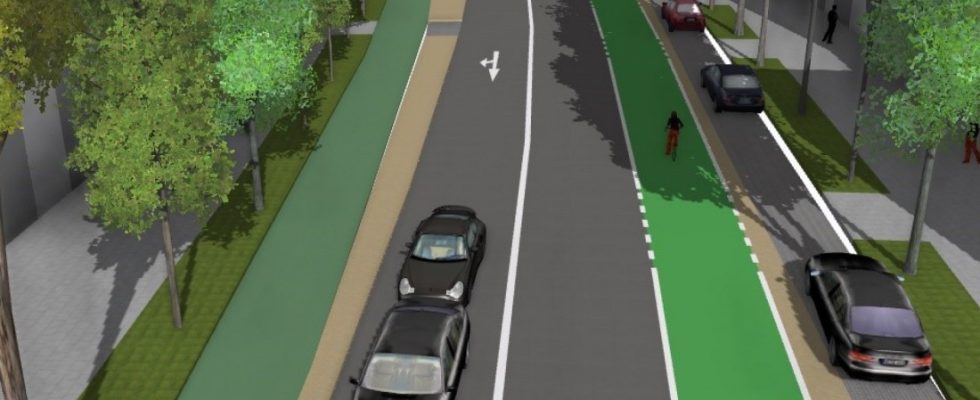Lindwurmstraße is one of the busiest streets within the Mittlerer Ring. But pedestrians and cyclists live dangerously on the 2.3-kilometer-long south-western connection between the city center and Sendling. According to the city, between 2011 and 2020 there were 168 accidents involving cyclists. 160 people were slightly injured, nine seriously.
That should change now. On Tuesday, the mobility department presented a plan that gives pedestrians and cyclists much more space, which should increase safety. But that also means that drivers are being deprived of space. In the past, they were allowed two lanes in each direction outside of the crossing areas and almost always parking spaces at the side of the road. In the future, one lane in each direction should be sufficient. Almost half of the 400 parking spaces are also to be eliminated in favor of bicycle and pedestrian traffic. Sufficient delivery zones should be created so that delivery traffic does not park on the future construction cycle paths or even on the road.
The narrow cycle paths and footpaths in particular are one reason for the frequent accidents. The cycle paths are only about one and a half meters wide, sometimes narrower. The sidewalks are only two to two and a half meters wide in some sections. Faster cyclists like to overtake due to lack of space on the pavement, which repeatedly leads to conflicts with passers-by. Because the cycle path is also behind the row of trees overgrown with high columnar poplars, it is difficult for drivers to see it when turning right. That’s why it crashes here regularly.
This is how it looks now (still): Two lanes for the cars, the bike paths are only about one and a half meters wide. The sidewalks are only two to two and a half meters wide in some sections.
(Photo: Visualization: City of Munich)
For Florian Paul, the city’s cycling officer, there is a “crass disproportion” between the volume of pedestrian and bicycle traffic and the available space on Lindwurmstrasse. For Paul, who cycles here almost every day, the redesign of the street is a “personal heart project”. The level of suffering, he says, is great, above all because cycling has increased by 70 percent within a decade.
9300 cyclists are out and about here every day
Depending on the section of road, up to 9,300 cyclists now use the route every day. Car traffic, on the other hand, has decreased by 35 percent since 2011. At that time, the city counted 28,600 motor vehicles per day in the somewhat more heavily frequented northern section of the road; in 2022 it was only 18,500.
According to Paul, there have been repeated considerations for years to improve the situation for cyclists on Lindwurmstrasse. But we have never been as far as we are now, he says. Benoit Blaser (Greens), chairman of the district committee (BA) Ludwigsvorstadt-Isarvorstadt, and Markus Lutz (SPD) from BA Sendling have seen a need for action for years, as they emphasized on Tuesday. Now, after the city council had already decided on the first package of measures for the Radentscheid in 2019, there is now a planning ready for a decision. This provides for cycle paths with a standard width of 2.50 meters on both sides. They will be moved in front of the line of trees where there are now car lanes or parking lots. This creates a lot of space for pedestrians, as the sidewalks will reach up to the trees.
The following applies to the lanes: only in the crossing areas will there be multiple lanes. Two lanes were also retained between Sendlinger-Tor-Platz and Reisingerstraße because regular buses operate here and should not be slowed down.
Something is also changing under the railway bridge
As far as the railway underpass between Implerstrasse and Poccistrasse is concerned, there are no lanes here either. Next year the railway will start with the renovation of the bridge. In the course of the work, the city is lowering the roadway to make room for a possible tram line.
The plan is expected to be presented to City Council later this year. If this votes for it, the building department gets involved with more detailed planning. If everything goes well, the conversion could start as early as 2025. The work should take about a year.
“We like the plans for Lindwurmstraße very much,” says Green City Councilor Gudrun Lux. “Here we’ve managed to achieve a good balance of interests.” By separating bicycle and pedestrian traffic, safety for both groups is increased enormously. “The planned bike lanes will be a great asset for this busy road.” In the future, Lux is convinced that even more people will be cycling more often.
Nikolaus Gradl, traffic expert of the SPD, is more reserved. “For us, the Lindwurmstraße is our top priority for a new cycle path. But we definitely don’t want a solution in which the poplar trees that characterize the cityscape have to be felled for a cycle path.” According to current plans, the poplars will remain. For this, the new cycle path has to make a detour from time to time. However, 37 trees are to be felled for the reconstruction of the railway bridge. As a replacement, the building department wants to plant 55 new ones later.
Veronika Mirlach, mobility policy spokeswoman for the CSU, is skeptical: the proposal will be examined professionally and discussed in the parliamentary group. The Lindwurmstraße is a main traffic artery into the city, for cyclists, but also for motorized traffic. “We also think that the cycle paths need to be improved. At the same time, however, it must be ensured that the Lindwurmstraße does not become a traffic jam,” says Mirlach.

